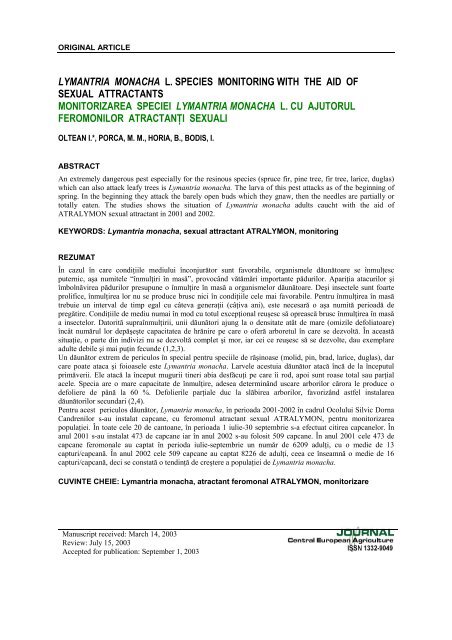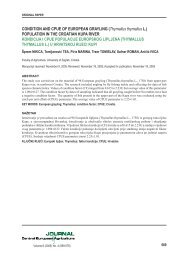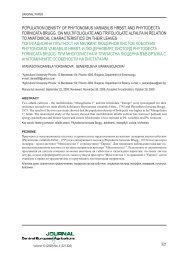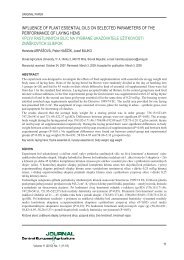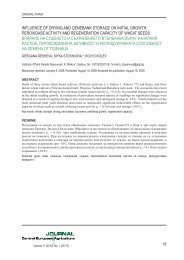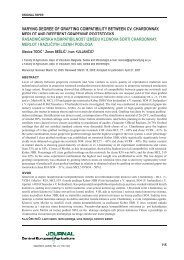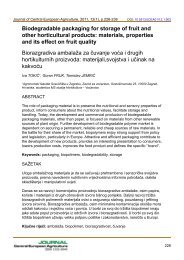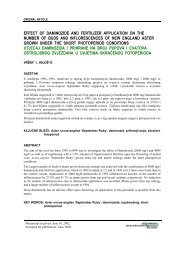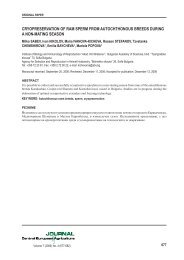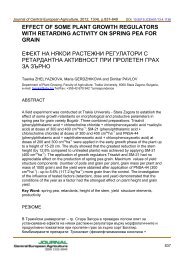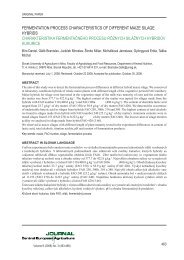lymantria monacha l. species monitoring with the aid of sexual ...
lymantria monacha l. species monitoring with the aid of sexual ...
lymantria monacha l. species monitoring with the aid of sexual ...
You also want an ePaper? Increase the reach of your titles
YUMPU automatically turns print PDFs into web optimized ePapers that Google loves.
ORIGINAL ARTICLE<br />
LYMANTRIA MONACHA L. SPECIES MONITORING WITH THE AID OF<br />
SEXUAL ATTRACTANTS<br />
MONITORIZAREA SPECIEI LYMANTRIA MONACHA L. CU AJUTORUL<br />
FEROMONILOR ATRACTANŢI SEXUALI<br />
OLTEAN I.*, PORCA, M. M., HORIA, B., BODIS, I.<br />
ABSTRACT<br />
An extremely dangerous pest especially for <strong>the</strong> resinous <strong>species</strong> (spruce fir, pine tree, fir tree, larice, duglas)<br />
which can also attack leafy trees is Lymantria <strong>monacha</strong>. The larva <strong>of</strong> this pest attacks as <strong>of</strong> <strong>the</strong> beginning <strong>of</strong><br />
spring. In <strong>the</strong> beginning <strong>the</strong>y attack <strong>the</strong> barely open buds which <strong>the</strong>y gnaw, <strong>the</strong>n <strong>the</strong> needles are partially or<br />
totally eaten. The studies shows <strong>the</strong> situation <strong>of</strong> Lymantria <strong>monacha</strong> adults caucht <strong>with</strong> <strong>the</strong> <strong>aid</strong> <strong>of</strong><br />
ATRALYMON <strong>sexual</strong> attractant in 2001 and 2002.<br />
KEYWORDS: Lymantria <strong>monacha</strong>, <strong>sexual</strong> attractant ATRALYMON, <strong>monitoring</strong><br />
REZUMAT<br />
În cazul în care condiţiile mediului înconjurător sunt favorabile, organismele dăunătoare se înmulţesc<br />
puternic, aşa numitele “înmulţiri în masă”, provocând vătămări importante pădurilor. Apariţia atacurilor şi<br />
îmbolnăvirea pădurilor presupune o înmulţire în masă a organismelor dăunătoare. Deşi insectele sunt foarte<br />
prolifice, înmulţirea lor nu se produce brusc nici în condiţiile cele mai favorabile. Pentru înmulţirea în masă<br />
trebuie un interval de timp egal cu câteva generaţii (câţiva ani), este necesară o aşa numită perioadă de<br />
pregătire. Condiţiile de mediu numai în mod cu totul excepţional reuşesc să oprească brusc înmulţirea în masă<br />
a insectelor. Datorită supraînmulţirii, unii dăunători ajung la o densitate atât de mare (omizile defoliatoare)<br />
încât numărul lor depăşeşte capacitatea de hrănire pe care o <strong>of</strong>eră arboretul în care se dezvoltă. În această<br />
situaţie, o parte din indivizi nu se dezvoltă complet şi mor, iar cei ce reuşesc să se dezvolte, dau exemplare<br />
adulte debile şi mai puţin fecunde (1,2,3).<br />
Un dăunător extrem de periculos în special pentru speciile de răşinoase (molid, pin, brad, larice, duglas), dar<br />
care poate ataca şi foioasele este Lymantria <strong>monacha</strong>. Larvele acestuia dăunător atacă încă de la începutul<br />
primăverii. Ele atacă la început mugurii tineri abia desfăcuţi pe care îi rod, apoi sunt roase total sau parţial<br />
acele. Specia are o mare capacitate de înmulţire, adesea determinând uscare arborilor cărora le produce o<br />
defoliere de până la 60 %. Defolierile parţiale duc la slăbirea arborilor, favorizând astfel instalarea<br />
dăunătorilor secundari (2,4).<br />
Pentru acest periculos dăunător, Lymantria <strong>monacha</strong>, în perioada 2001-2002 în cadrul Ocolului Silvic Dorna<br />
Candrenilor s-au instalat capcane, cu feromonul atractant <strong>sexual</strong> ATRALYMON, pentru monitorizarea<br />
populaţiei. În toate cele 20 de cantoane, în perioada 1 iulie-30 septembrie s-a efectuat citirea capcanelor. În<br />
anul 2001 s-au instalat 473 de capcane iar în anul 2002 s-au folosit 509 capcane. În anul 2001 cele 473 de<br />
capcane feromonale au captat în perioda iulie-septembrie un număr de 6209 adulţi, cu o medie de 13<br />
capturi/capcană. În anul 2002 cele 509 capcane au captat 8226 de adulţi, ceea ce înseamnă o medie de 16<br />
capturi/capcană, deci se constată o tendinţă de creştere a populaţiei de Lymantria <strong>monacha</strong>.<br />
CUVINTE CHEIE: Lymantria <strong>monacha</strong>, atractant feromonal ATRALYMON, monitorizare<br />
Manuscript received: March 14, 2003<br />
Review: July 15, 2003<br />
Accepted for publication: September 1, 2003
OLTEAN I., PORCA, M. M., HORIA, B., BODIS, I.<br />
DETAILED ABSTRACT<br />
The case in which <strong>the</strong> environment conditions are favourable, <strong>the</strong> organisms noxious strongly multiply, <strong>the</strong><br />
so-called “mass multiplication”, causing important damages to forests. The occurrence <strong>of</strong> <strong>the</strong> attacks and<br />
forests sickening presumes a mass multiplication <strong>of</strong> noxious organisms. An extremely dangerous pest<br />
especially for <strong>the</strong> resinous <strong>species</strong> (spruce fir, pine tree, fir tree, larice, duglas) which can also attack leafy<br />
trees is Lymantria <strong>monacha</strong>. The larva <strong>of</strong> this pest attacks as <strong>of</strong> <strong>the</strong> beginning <strong>of</strong> spring. In <strong>the</strong> beginning <strong>the</strong>y<br />
attack <strong>the</strong> barely open buds which <strong>the</strong>y gnaw, <strong>the</strong>n <strong>the</strong> needles are partially or totally eaten. The <strong>species</strong> has a<br />
great multiplication capacity, <strong>of</strong>ten determining trees drying as it produces an exfoliation <strong>of</strong> up to 60 %.<br />
Partial exfoliation lead to trees weakening thus making way for <strong>the</strong> installation <strong>of</strong> secondary pests. In order to<br />
monitor <strong>the</strong> population <strong>of</strong> this Lymantria <strong>monacha</strong> pest, traps were installed during <strong>the</strong> 2001 – 2002 period,<br />
<strong>with</strong> <strong>the</strong> <strong>sexual</strong> attractant ATRALYMON. In all <strong>the</strong> 20 cantons <strong>the</strong> reading <strong>of</strong> <strong>the</strong> traps was done between<br />
July 1- September 30. In 2001, 473 traps were installed as compared to 2002 when 509 traps were open.<br />
246<br />
Journal <strong>of</strong> Central European Agriculture (online), Volume 4 (2003) No3
LYMANTRIA MONACH L SPECIES MONITORING WITH THE AID OF SEXUAL ATTRACTANTS<br />
INTRODUCTION<br />
Vegetable and animal organisms noxious to forests<br />
usually have an insignificant influence on <strong>the</strong> life <strong>of</strong><br />
<strong>the</strong> forest, because, <strong>the</strong>ir number being small, <strong>the</strong><br />
damage <strong>the</strong>y produce may stay unnoticed. The<br />
period during which pests do not cause damages<br />
because <strong>the</strong>ir number is reduced is called period <strong>of</strong><br />
latency. The case in which <strong>the</strong> environment<br />
conditions are favourable, <strong>the</strong>se organisms strongly<br />
multiply, <strong>the</strong> so-called “mass multiplication”,<br />
causing important damages to forests. The<br />
occurrence <strong>of</strong> <strong>the</strong> attacks and forests sickening<br />
presumes a mass multiplication <strong>of</strong> noxious<br />
organisms (1,2). Generally, organisms noxious to<br />
forests have <strong>the</strong> capacity to multiply very much, still,<br />
<strong>the</strong>y do not reach but seldom high densities. To<br />
insects multiplication capacity opposes, usually, a<br />
series <strong>of</strong> factors which contribute to <strong>the</strong>ir destruction<br />
to such an extent that <strong>the</strong>ir number stays for a long<br />
time to a decreased level. Though insects are very<br />
prolific, <strong>the</strong>ir multiplication does not occur all <strong>of</strong> a<br />
sudden not even under <strong>the</strong> most favourable<br />
conditions. Mass multiplication needs a lapse <strong>of</strong> time<br />
equal to some generations (some years), it is<br />
necessary <strong>the</strong> so-called preparation period. The<br />
environment conditions only exceptionally manage<br />
to suddenly stop insects mass multiplication.<br />
When, due to certain causes, some environment<br />
factors which tend to hinder <strong>the</strong> mass multiplication<br />
<strong>of</strong> an insect act in a weaker manner, its descendants<br />
survive in a greater number and determine <strong>the</strong> mass<br />
multiplication <strong>of</strong> that <strong>species</strong>. The preservation <strong>of</strong><br />
such a situation results in <strong>the</strong> more and more<br />
numerical increase <strong>of</strong> insects in <strong>the</strong> following years.<br />
Due to over-multiplication, some pests reach a<br />
density so great (exfoliating caterpillars) that <strong>the</strong>ir<br />
number exceeds <strong>the</strong> feeding capacity <strong>of</strong>fered by <strong>the</strong><br />
brush in which <strong>the</strong>y develop. In such a situation, part<br />
<strong>of</strong> <strong>the</strong> individuals do not develop completely and die,<br />
and those which fully develop result in adults which<br />
are feeble and less fertile. At <strong>the</strong> same time <strong>with</strong> <strong>the</strong><br />
pests mass multiplication, parasites and entomophagi<br />
find optimal development conditions as <strong>the</strong>y have<br />
abundant food. Parasites activity is remarked through<br />
an ever increasing mortality amongst <strong>the</strong> pests,<br />
eventually reducing <strong>the</strong>m to <strong>the</strong> extremely small<br />
initial number. This stop <strong>of</strong> <strong>the</strong> gradation is<br />
performed most <strong>of</strong> <strong>the</strong> times only after <strong>the</strong> bush<br />
suffered repeated exfoliation (3).<br />
An extremely dangerous pest especially for <strong>the</strong><br />
resinous <strong>species</strong> (spruce fir, pine tree, fir tree, larice,<br />
duglas) which can also attack leafy trees is<br />
Lymantria <strong>monacha</strong>. The larva <strong>of</strong> this pest attacks as<br />
<strong>of</strong> <strong>the</strong> beginning <strong>of</strong> spring. In <strong>the</strong> beginning <strong>the</strong>y<br />
attack <strong>the</strong> barely open buds which <strong>the</strong>y gnaw, <strong>the</strong>n<br />
<strong>the</strong> needles are partially or totally eaten. The <strong>species</strong><br />
has a great multiplication capacity, <strong>of</strong>ten determining<br />
trees drying as it produces an exfoliation <strong>of</strong> up to 60<br />
%. Partial exfoliation lead to trees weakening thus<br />
making way for <strong>the</strong> installation <strong>of</strong> secondary pests<br />
(1,2,4).<br />
MATERIAL AND METHOD<br />
In order to monitor <strong>the</strong> population <strong>of</strong> this Lymantria<br />
<strong>monacha</strong> pest, traps were installed during <strong>the</strong> 2001 –<br />
2002 period, <strong>with</strong> <strong>the</strong> <strong>sexual</strong> attractant<br />
ATRALYMON. In all <strong>the</strong> 20 cantons <strong>the</strong> reading <strong>of</strong><br />
<strong>the</strong> traps was done between July 1- September 30. In<br />
2001, 473 traps were installed as compared to 2002<br />
when 509 traps were open.<br />
RESULTS AND DISCUSSION<br />
Table 1 shows <strong>the</strong> situation <strong>of</strong> Lymantria <strong>monacha</strong><br />
adults caucht <strong>with</strong> <strong>the</strong> <strong>aid</strong> <strong>of</strong> ATRALYMON <strong>sexual</strong><br />
attractant in 2001. Between July – September <strong>the</strong><br />
473 atractant traps caught a number <strong>of</strong> 6,209 adults,<br />
<strong>with</strong> an average <strong>of</strong> 13 captures/trap. We find that all<br />
<strong>the</strong> traps had captures (in all <strong>the</strong> 20 forest cantons). If<br />
we analyze <strong>the</strong> situations by districts, we find that in<br />
<strong>the</strong> Voroava district <strong>the</strong> lowest population <strong>of</strong> <strong>the</strong> pest<br />
is to be seen. Here, <strong>the</strong> average number <strong>of</strong><br />
butterflies/trap was <strong>of</strong> two and five in <strong>the</strong> Arşiţa<br />
canton. Even <strong>the</strong> maximum number <strong>of</strong> captures/trap<br />
in this district was <strong>the</strong> lowest (7 captures in <strong>the</strong><br />
Voroava and Marişel cantons and 8 at Arşiţa). A<br />
more numerically reduced population is to be found<br />
in <strong>the</strong> Strunior district <strong>with</strong> an average <strong>of</strong> 8<br />
captures/trap and <strong>of</strong> 10 captures/trap in <strong>the</strong> Izvoare<br />
canton. Within <strong>the</strong> Dornişoara district <strong>the</strong> situation<br />
differs a lot from one canton to ano<strong>the</strong>r. Thus, if in<br />
<strong>the</strong> Muncel canton was registered an average <strong>of</strong> 3<br />
captures/trap, in <strong>the</strong> Măgura canton an average <strong>of</strong> 40<br />
captures/trap was performed. Still in this canton <strong>the</strong><br />
greatest number <strong>of</strong> captures/trap was realized, as we<br />
found 50 captures/trap. The situation was relatively<br />
similar in <strong>the</strong> districts Negrişoara and Roşia, <strong>the</strong><br />
populations differing very much from one canton to<br />
ano<strong>the</strong>r (from 3 to 25 captures).<br />
Journal <strong>of</strong> Central European Agriculture (online), Volume 4 (2003) No3 247
OLTEAN I., PORCA, M. M., HORIA, B., BODIS, I.<br />
248<br />
Table 1: Situation Lymantria <strong>monacha</strong> captures <strong>with</strong> <strong>the</strong> <strong>aid</strong> <strong>of</strong> <strong>the</strong> <strong>sexual</strong> attractant (ATRALYMON).<br />
The Dorna Candrenilor Forest Range (2001)<br />
District CANTONS<br />
I<br />
Negrişoara<br />
II<br />
Roşia<br />
III<br />
Dornişoara<br />
IV<br />
Voroava<br />
V<br />
Number <strong>of</strong><br />
Atractant<br />
traps<br />
Number <strong>of</strong><br />
Captures<br />
Number <strong>of</strong><br />
Captures/<br />
traps<br />
Maximum<br />
number <strong>of</strong><br />
Captures/<br />
traps<br />
Pârâul pietri 17 281 16 28<br />
Gligu 29 547 19 32<br />
Ascuţita 32 258 8 15<br />
Negrişoara 32 709 22 37<br />
Smizi 15 354 24 32<br />
T<strong>of</strong>la 18 447 25 31<br />
Roşia 27 637 23 31<br />
Praji 22 422 19 30<br />
Tirov 25 86 3 9<br />
Faţa tătarului 17 198 12 18<br />
Muncel 28 94 3 12<br />
Valea largǎ 25 267 13 20<br />
Zimbrişor 14 261 19 25<br />
Zimbru 14 213 15 18<br />
Mǎgura 20 804 40 50<br />
Arşiţa 26 141 5 8<br />
Voroava 28 65 2 7<br />
Mǎrişel 27 81 3 7<br />
Izvoare 30 128 10 13<br />
Strunior Strunior 27 216 8 19<br />
TOTAL 473 6209 13 50<br />
Table 2: Situation Lymantria <strong>monacha</strong> captures <strong>with</strong> <strong>the</strong> <strong>aid</strong> <strong>of</strong> <strong>the</strong> <strong>sexual</strong> attractant (ATRALYMON).<br />
The Dorna Candrenilor Forest Range (2002)<br />
District CANTONS<br />
I<br />
Negrişoara<br />
II<br />
Roşia<br />
III<br />
Dornişoara<br />
IV<br />
Voroava<br />
V<br />
Number <strong>of</strong><br />
Atractant<br />
traps<br />
Number <strong>of</strong><br />
Captures<br />
Number <strong>of</strong><br />
Captures/<br />
traps<br />
Maximum<br />
number <strong>of</strong><br />
Captures/<br />
Traps<br />
Pârâul pietri 21 445 21 29<br />
Gligu 25 504 20 30<br />
Ascuţita 30 446 15 27<br />
Negrişoara 31 841 27 32<br />
Smizi 18 572 32 41<br />
T<strong>of</strong>la 20 543 27 33<br />
Roşia 25 572 23 30<br />
Praji 27 488 18 31<br />
Tirov 29 230 8 17<br />
Faţa tǎtarului 22 312 14 20<br />
Muncel 24 121 5 11<br />
Valea largǎ 26 472 18 29<br />
Zimbrişor 18 430 24 32<br />
Zimbru 20 403 20 29<br />
Mǎgura 22 1061 48 59<br />
Arşiţa 28 110 4 10<br />
Voroava 31` 95 3 11<br />
Mǎrişel 30 119 4 9<br />
Izvoare 32 253 8 15<br />
Strunior Strunior 30 209 7 19<br />
TOTAL 509 8226 16 59<br />
Journal <strong>of</strong> Central European Agriculture (online), Volume 4 (2003) No3
LYMANTRIA MONACH L SPECIES MONITORING WITH THE AID OF SEXUAL ATTRACTANTS<br />
Generally, <strong>the</strong> situation <strong>of</strong> <strong>the</strong> Lymantria <strong>monacha</strong><br />
captures in 2002 (table 2) shows a slight increase<br />
tendency (in <strong>the</strong> forest range as a whole). That year<br />
<strong>the</strong> 509 traps caught 8,226 adults which means an<br />
average <strong>of</strong> 16 captures/trap. A reduced population<br />
was seen in <strong>the</strong> Voroava and Strunior districts.<br />
An average <strong>of</strong> 3-4 captures/trap were registered in<br />
Voroava and in Strunior 7-8 captures/trap.The<br />
Dornişoara district witnessed that year too <strong>the</strong><br />
greatest number <strong>of</strong> captures/trap. Thus, in Măgura 59<br />
adults/trap were captured. In <strong>the</strong> o<strong>the</strong>r districts <strong>the</strong><br />
situation is almost identical <strong>with</strong> <strong>the</strong> preceding year.<br />
REFERENCES<br />
[1.]Holonec L., Cherecheşiu V., 2002, Starea de<br />
sănătate a pădurilor, Rev. Protecţia Plantelor,<br />
nr.46, p 58-65.<br />
[2.]Marcu Olimpia, I. Tudor, 1976, Protecţia<br />
pădurilor, Ed. Didactică şi pedagogică Bucureşti,<br />
p.241-274<br />
CONCLUSION<br />
In <strong>the</strong> forest cantons <strong>of</strong> <strong>the</strong> Dorne area, <strong>the</strong> most<br />
dangerous pest for coniferous trees is Lymantria<br />
<strong>monacha</strong><br />
The <strong>monitoring</strong> <strong>of</strong> <strong>the</strong> exfoliating Lymantria<br />
<strong>monacha</strong>. is easy <strong>with</strong> <strong>the</strong> <strong>aid</strong> <strong>of</strong> <strong>the</strong> ATRALYMON<br />
<strong>sexual</strong> attractant <strong>with</strong> a great attraction power.<br />
In <strong>the</strong> area <strong>of</strong> <strong>the</strong> Dorne, <strong>the</strong> Lymantria <strong>monacha</strong>.<br />
<strong>species</strong> presents a slight population increase<br />
tendency.<br />
[3.]Oltean I., T. Perju, Timuş Asea, 2001, Insecte<br />
fit<strong>of</strong>age dăunătoare ale plantelor cultivate, Ed.<br />
Poliam ,Cluj-Napoca.<br />
[4.]Tudor I., 1991, Lymantria <strong>monacha</strong> şi<br />
combaterea ei în Carpaţii Orientali, Editura<br />
Agricolă, Bucureşti.<br />
Journal <strong>of</strong> Central European Agriculture (online), Volume 4 (2003) No3 249
I. OLTEAN, PORCA, M. M., HORIA, B., BODIS, I.<br />
ADDRESS OF AUTHORS<br />
Ion Oltean*: ionoltean@personal.ro; Monica Maria Porca, Horia Bunescu, Ilonka Bodis<br />
Faculty <strong>of</strong> Agriculture, University <strong>of</strong> Agricultural Sciences and Veterinary Medicine,<br />
Cluj-Napoca, Romania<br />
Tel.: +40-264-596384<br />
Fax.: +40-264-593793<br />
*Author for correspondence<br />
250<br />
Journal <strong>of</strong> Central European Agriculture (online), Volume 4 (2003) No3


